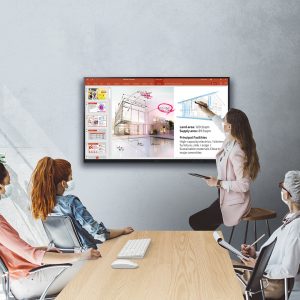
From self-service kiosks at restaurants, to animated billboards, to adaptive screens in boardrooms, digital signage is here to stay.
The workplace reimagined
Now that many employees are working remotely or in a hybrid arrangement where they only go into a physical office periodically, businesses have been tasked with finding ways to connect their teams in a seamless and collaborative way.
This is where digital signage comes in.
Technology will drive how these revamped workplaces operate, with digital signage informing, guiding, and motivating staff—on displays at desks and everywhere from lobbies and common areas to high-density seating areas. As workers will only be visiting the office on a part-time basis in these hybrid arrangements, it’s more important than ever for businesses to create an atmosphere that is conducive to productivity and collaboration.
To do this, workplaces need to introduce the right tools and communication technologies to help their whole team understand their updated operations and where they need to be. To inform, recognize, and inspire their teams—and keep them engaged—digital displays and monitors play a critical role in ensuring success.
In a physical office, high-definition video walls, which are now one of the fastest-growing subsegments of audio/video (A/V) displays for corporate use, and indoor LED signage can offer transformative ways to communicate, whether installed individually or as part of a seamless, large-palette LED screen.
For boardroom meetings, employees connecting remotely will feel more included with remote conferencing tools and digital displays, such as collaborative whiteboards and interactive screens that offer a smooth pen-to-paper-like writing experience and allow individuals joining from anywhere to share information and notate in real time. Larger meeting rooms might benefit from the use of a full LED video wall to improve team communication and display compelling visuals while smaller rooms might require fixed-size LED bundles or large flat-panel LCD and QLED displays.
Other popular tools include integrated videoconferencing display solutions that can be customized so workers can initiate meetings on their mobile device and push the content to office displays. On-screen support for multiple operating systems and security solutions allow employees
to use their own devices, IT-approved software, and
peripheral equipment.
As workers gradually return to physical offices, digital signage in entryways, hallways, and other common areas can provide them with peace of mind by promoting new health and safety guidelines and reminding employees about critical protocols and information. Digital displays can also
provide contactless wayfinding and issue alerts in the case of an emergency.
The possibilities are endless, but what’s clear is consumers both welcome and expect screens as part of their daily interactions. The businesses that recognize this and embrace it will be the most successful in the long run because they will be well-equipped to adapt to consumers’ and employees’ evolving lifestyles and needs.
A seasoned enterprise business leader, Mary Peterson is vice-president, enterprise business division, for Samsung Electronics Canada, where she shapes the strategic vision for the company’s commercial digital display solutions in Canada. Throughout her extensive career in the technology industry, she has led successful business divisions within the Canadian operations of some of the world’s most respected technology companies.





